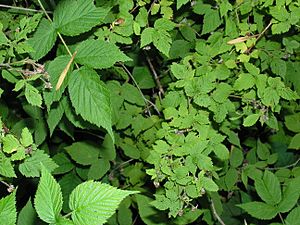American red raspberry facts for kids
Quick facts for kids American red raspberry |
|
|---|---|
 |
|
| Rubus strigosus near Matanuska Glacier, Alaska | |
| Scientific classification | |
| Kingdom: | |
| (unranked): | |
| (unranked): | |
| (unranked): | |
| Order: | |
| Family: | |
| Genus: | |
| Subgenus: | |
| Species: |
R. strigosus
|
| Binomial name | |
| Rubus strigosus |
|
The Rubus strigosus, also called the American red raspberry, is a type of raspberry plant. It grows naturally across much of North America. This plant is often seen as a separate species from the European red raspberry (Rubus idaeus).
Many of the raspberries you might eat come from special types. These are created by mixing the American red raspberry with the European red raspberry.
About This Raspberry
Botanists, who are scientists studying plants, have discussed how to group the American and European red raspberries. Some think they are all part of one large species. Others believe they are different species.
These two types of raspberries are very similar. They likely came from a common ancestor a long time ago. Today, many scientists classify the North American red raspberries as Rubus strigosus. The European plants are called Rubus idaeus.
One main difference helps tell them apart. R. strigosus usually has tiny hairs with glands on its new stems. It also has these hairs on its leaf stalks and flower parts. The European R. idaeus does not have these gland-tipped hairs.
Where It Grows
The American red raspberry (Rubus strigosus) grows widely in North America. It is especially common in colder, northern areas.
Some experts also say that certain raspberries in eastern Asia belong to this group. However, others include all Asian raspberries with the European R. idaeus.
What It Looks Like
R. strigosus is a perennial plant. This means its roots live for many years. It grows new stems, called "canes," each year. These canes live for two years, which means they are biennial.
In its first year, a new cane grows tall, usually 0.5 to 2 meters (about 1.5 to 6.5 feet). It does not branch out and has large leaves. These leaves usually have three or five smaller parts, called leaflets. First-year canes normally do not produce any flowers.
In its second year, the cane stops growing taller. Instead, it grows several side shoots. These shoots have smaller leaves, usually with three leaflets.
The flowers appear in late spring. They grow on short clusters at the tips of these side shoots. Each flower has five white petals, about 4 to 7 millimeters (0.16 to 0.28 inches) long.
The fruit is about 1 to 1.2 centimeters (0.4 to 0.5 inches) wide. It is red, edible, and tastes sweet but a bit tart. The fruit grows in summer or early autumn. In botany, this fruit is not a true berry. Instead, it is an aggregate fruit. This means it is made of many tiny, individual fruits called drupelets, all clustered around a central core.


